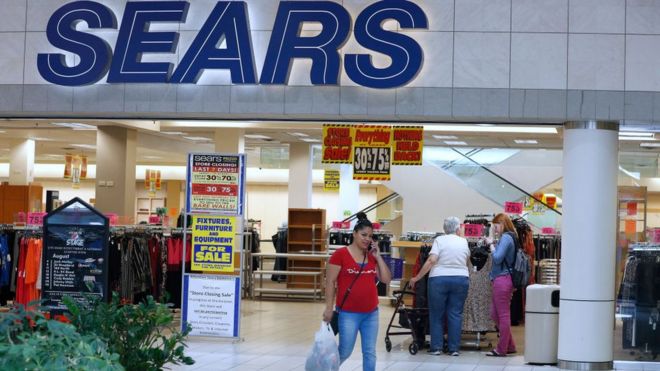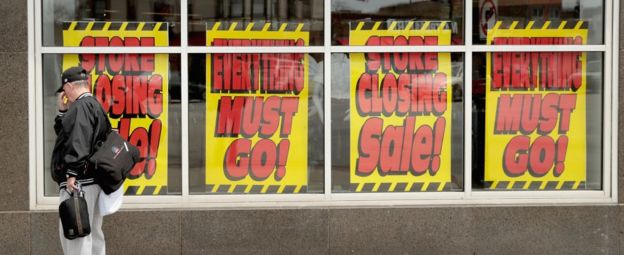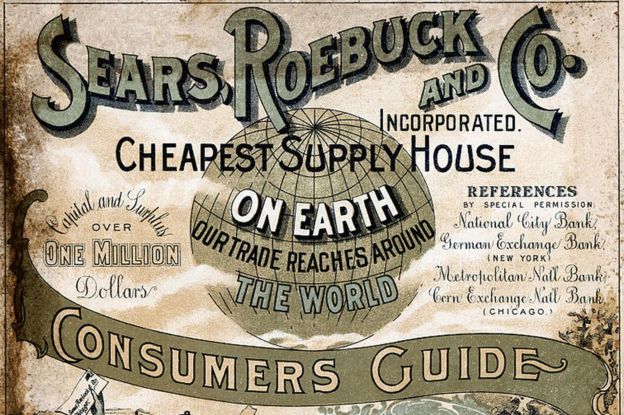US retail giant Sears files for bankruptcy

Sears, the US department store chain that once dominated America's shopping malls, has filed for bankruptcy.
Sears Holdings - which also owns Kmart - filed for Chapter 11 bankruptcy protection on Monday.
The company has suffered, along with many other traditional retailers, from rising online competition from firms such as Amazon.
Sears has been closing stores and selling properties as it grapples with debts of more than $5bn.
The company employs nearly 90,000 people in the US, although that is down from 246,000 five years ago, and in its heyday it had more than 3,000 stores.
It became America's largest retailer before being overtaken by Walmart in the 1980s.
The firm filed for bankruptcy petition after it reportedly could not meet a $134m repayment due on Monday.
Chapter 11 protection postpones a US company's obligations to its creditors, giving it time to reorganise its debts or sell parts of the business.

Media captionSears struggles for shopping relevancy
Eddie Lampert - who is the company's chief executive, biggest investor and landlord - had attempted to restructure its debts to avoid bankruptcy.
In a statement, he said: "Over the last several years, we have worked hard to transform our business and unlock the value of our assets.
ADVERTISEMENT
"While we have made progress, the plan has yet to deliver the results we have desired."
Announcing its bankruptcy filing, Sears also said it would close 142 unprofitable stores by the end of the year, on top of the previously announced closure of 46 stores by November.
Analysis:
by Kim Gittleson, New York business correspondent

Entering a Sears in 2018 was like travelling back in time - and not in a good way.
Chronic underinvestment in the company's physical stores meant that shelves were often empty and signs for products were handwritten.
That's assuming you found a reason to walk into a Sears in the first place. By the mid-1990s most of what Sears sold was available elsewhere, often at a discount.
Ironically for a company who rose to prominence with its catalogues and its use of the US Postal Service to deliver nearly everything, everywhere (sound familiar?), the modern-day Sears seemed averse to investing significantly in any e-commerce presence.
With some of its best-located stores sold off in a push to raise capital, it eventually became even more difficult to find a Sears - Walmart has over 5,000 locations in the US; Target has over 1,800; even Macy's has over 800 stores.
While Sears' closure of another 142 locations certainly marks an end of an era in US retailing, the reality is that Americans still love to shop, even in physical stores, if you give them a reason.
They just didn't want to shop at Sears.
'Tarnished' brand
Some analysts say Sears' problems were exacerbated by a lack of investment in stores.
Neil Saunders of GlobalData Retail said Sears' troubles began in the 1980s when it became "too diversified and lost the deftness that had once made it the world's largest and most innovative retailer".
"That a storied retailer, once at the pinnacle of the industry, should collapse in such a shabby state of disarray is both terrible and scandalous," he said.
"The brand is now tarnished just as the economics of its model are firmly stacked against its future success."

Sears was founded by Richard Warren Sears and Alvah Curtis Roebuck in 1886 as a mail order catalogue company. It opened its first retail locations in 1925 and eventually became a fixture in shopping malls across the US.
It was America's largest retailer by revenue until 1989, when Walmart overtook it,
Mr Lampert's hedge fund, ESL Investments, took a stake in Sears in 2004, later combining it with Kmart with the aim of restoring its profitability.
He and his affiliates now own about 49% of Sears.
Despite the investment, Sears never regained its footing. It racked up more than $6bn in losses between 2013 and 2017, while annual revenues fell to $16.7bn in 2017, almost half the $31.2bn posted in 2014.
As of August, the retailer had more than 860 stores in the US, down from 1,700 at the end of 2014.
Sears Canada, which was spun-off from the main company in 2012, filed for bankruptcy last year, with the loss of thousands of jobs.

Sears, the US department store chain that once dominated America's shopping malls, has filed for bankruptcy.
Sears Holdings - which also owns Kmart - filed for Chapter 11 bankruptcy protection on Monday.
The company has suffered, along with many other traditional retailers, from rising online competition from firms such as Amazon.
Sears has been closing stores and selling properties as it grapples with debts of more than $5bn.
The company employs nearly 90,000 people in the US, although that is down from 246,000 five years ago, and in its heyday it had more than 3,000 stores.
It became America's largest retailer before being overtaken by Walmart in the 1980s.
The firm filed for bankruptcy petition after it reportedly could not meet a $134m repayment due on Monday.
Chapter 11 protection postpones a US company's obligations to its creditors, giving it time to reorganise its debts or sell parts of the business.

Media captionSears struggles for shopping relevancy
Eddie Lampert - who is the company's chief executive, biggest investor and landlord - had attempted to restructure its debts to avoid bankruptcy.
In a statement, he said: "Over the last several years, we have worked hard to transform our business and unlock the value of our assets.
ADVERTISEMENT
"While we have made progress, the plan has yet to deliver the results we have desired."
Announcing its bankruptcy filing, Sears also said it would close 142 unprofitable stores by the end of the year, on top of the previously announced closure of 46 stores by November.
Analysis:
by Kim Gittleson, New York business correspondent

Entering a Sears in 2018 was like travelling back in time - and not in a good way.
Chronic underinvestment in the company's physical stores meant that shelves were often empty and signs for products were handwritten.
That's assuming you found a reason to walk into a Sears in the first place. By the mid-1990s most of what Sears sold was available elsewhere, often at a discount.
Ironically for a company who rose to prominence with its catalogues and its use of the US Postal Service to deliver nearly everything, everywhere (sound familiar?), the modern-day Sears seemed averse to investing significantly in any e-commerce presence.
With some of its best-located stores sold off in a push to raise capital, it eventually became even more difficult to find a Sears - Walmart has over 5,000 locations in the US; Target has over 1,800; even Macy's has over 800 stores.
While Sears' closure of another 142 locations certainly marks an end of an era in US retailing, the reality is that Americans still love to shop, even in physical stores, if you give them a reason.
They just didn't want to shop at Sears.
'Tarnished' brand
Some analysts say Sears' problems were exacerbated by a lack of investment in stores.
Neil Saunders of GlobalData Retail said Sears' troubles began in the 1980s when it became "too diversified and lost the deftness that had once made it the world's largest and most innovative retailer".
"That a storied retailer, once at the pinnacle of the industry, should collapse in such a shabby state of disarray is both terrible and scandalous," he said.
"The brand is now tarnished just as the economics of its model are firmly stacked against its future success."

Sears was founded by Richard Warren Sears and Alvah Curtis Roebuck in 1886 as a mail order catalogue company. It opened its first retail locations in 1925 and eventually became a fixture in shopping malls across the US.
It was America's largest retailer by revenue until 1989, when Walmart overtook it,
Mr Lampert's hedge fund, ESL Investments, took a stake in Sears in 2004, later combining it with Kmart with the aim of restoring its profitability.
He and his affiliates now own about 49% of Sears.
Despite the investment, Sears never regained its footing. It racked up more than $6bn in losses between 2013 and 2017, while annual revenues fell to $16.7bn in 2017, almost half the $31.2bn posted in 2014.
As of August, the retailer had more than 860 stores in the US, down from 1,700 at the end of 2014.
Sears Canada, which was spun-off from the main company in 2012, filed for bankruptcy last year, with the loss of thousands of jobs.